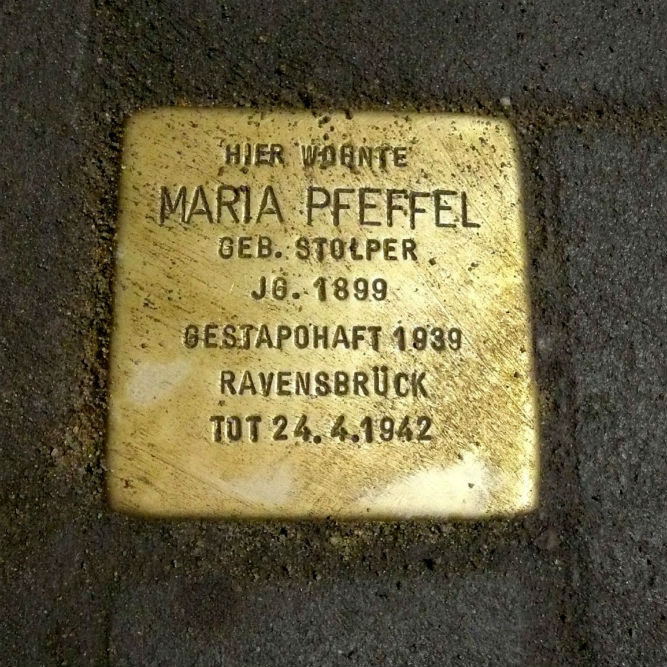Stumbling Stone Wilhelmstraße 3
This memorial stone (Stolperstein or stumbling block) commemorates:
* Maria Pfeffel née Stolper, born 1899, Gestapo detention 1939, Ravensbrück, dead 24 April 1942.
Maria (Michla, Manja) Stolper was born in Latvia. In the 1920s in Cottbus, she married Oswald Pfeffel, a manufacturer. He was not Jewish. They had two children – Rita (b. 1921) and Eugen (b. 1922) and lived at Vetschauer Str. 1 in Cottbus. The marriage did not last; she filed for divorce in 1929. The divorce was final in 1934, and a court order allowed Oswald to keep the the children. Maria moved to Wilhelmstrasse, now without the protection of being married to a non-Jew. Her children’s mixed status gave her some minimal protection. But in 1939, she was forced to abandon her apartment and move to a Jewish House. Lawyer Hermann Hammerschmidt protested the arbitrariness of the seizure of her property since she was the mother of mixed children. (A Stolperstein for Hammerschmidt is at Bahnhofstraße 62 in Cottbus.)
A Cottbus police report from around that time, described her: "... Russian Jewess, elegantly dressed, does not carry out any activity, denies the approval of tax information at the tax office, she complains against any police or official action." [from LR Online, below.]
Maria Pfeffel was arrested by the Gestapo on 16 November 1939 – the accusation was impudence (Frechheit). She was next deported to Ravensbrück concentration camp. According to Yad Vashem, she was then deported in April 1942 from Ravensbrück to Bernburg Saale Camp in Germany, a sanatorium and mental hospital. One wing was turned into a euthanasia center where disabled and ill people were killed, as were prisoners from some concentration camps. The method was carbon monoxide gas. In the spring of 1942, around 1,600 women from Ravensbrück, selected as unfit for work, had been killed in the Bernburg Euthanasia Center.
"Stolpersteine" is an art project for Europe by Gunter Demnig to commemorate victims of National Socialism (Nazism). Stolpersteine (stumbling stones) are small, 10x10cm brass plaques placed in the pavement in front of the last voluntary residence of (mostly Jewish) victims who were murdered by the Nazis. Each plaque is engraved with the victim’s name, date of birth, and place (mostly a concentration camp) and date of death. By doing this, Gunter Demnig gives an individual memorial to each victim. One stone, one name, one person. He cites the Talmud: "A human being is forgotten only when his or her name is forgotten."
Do you have more information about this location? Inform us!
Source
- Text: Fedor de Vries & Anne Palmer
- Photos: wie-wolf
- LR Online: Cottbuserin stirbt … in der "Hölle der Frauen"
- Yad Vashem Central Database of Shoah Victims’ Names
- USHMM: Ravensbrück
- Stolpersteine.eu
Nearby
Point of interest
Monument
- Soviet War Memorial Cottbus - Cottbus
- War Memorial Kiekenbusch - Kiekenbusch (Cottbus)
- War Memorial Leuthen - Leuthen
Cemetery
- Mass Grave Soviet Soldiers Cottbus - Cottbus
- Mass Grave Polish Forced Laborers - Cottbus
- German War Graves Cottbus - Cottbus





